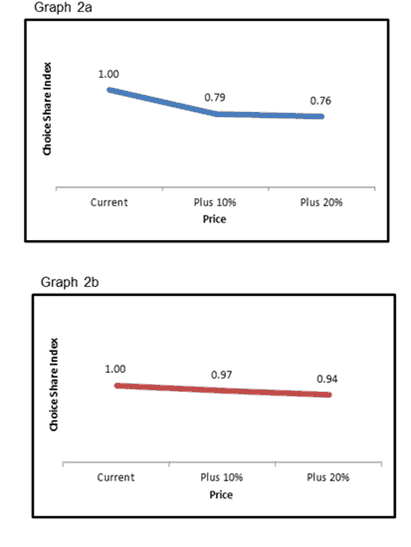Discovering Key Price Points with Choice-based Models
What are the benefits of conducting pricing marketing research? In this edition of Pricing for Researchers we discuss two key benefits: (i) the prediction of consumers’ response to price changes, and (ii) the discovery of psychological effects of price points on sales (demand). Pricing strategies based on accurate predictions of potential outcomes gives organizations a strong advantage and the opportunity to improve revenue.
Article By: Claudia López, Research Consultant, Pricing Solutions Ltd.
This edition of Pricing Solutions’ Pricing for Researchers discusses two key benefits of conducting pricing marketing research: (i) the prediction of consumers’ response to price changes, and (ii) the discovery of psychological effects of price points on sales (demand). Pricing strategies based on accurate predictions of potential outcomes gives organizations a strong advantage and the opportunity to improve revenue.
One of the most difficult challenges in the management sector is determining the effect of changing prices on sales volume. It is expected that sales will drop after a price increase but what is crucial to understand is, by how much? Would the drop in sales equal the increase of prices, percentage wise? Would sales drop at a rate greater or less than that of the price increase? Graphs 1a, 1b and 1c show 3 potential outcomes:
For companies selling directly to consumers, this challenge also includes the understanding of psychological effects of pricing. Consumers perceive additional messaging/information from prices and react atypically to certain types of prices. Price points, price structures, price formats, price framing and price communication are among the most examined psychological effects of pricing [1].
In the presence of psychological pricing, consumers will react more drastically at key price points. This results in a ‘kinked’ demand curve (sales) with inflexion points. As Paul Hunt & Jim Saunders explain in World Class Pricing: The Journey, “once you price over a ‘pricing threshold’, demand may drop precipitously.”.[2, pp. 115] One reasoning for this being consumers perceive these price points as being significantly lower than they actually are.
Consumers usually process prices by focusing on the far left digit [3], and separating prices into parts instead of processing them as an entity [4]. For example; $0.99 would seem a lot cheaper than $1.00 even though it is only 1 cent less. “Even expensive homes in Beverly Hills might sell for $7,995,000 rather than $8 million.” [3]
To evaluate new prices, one must be able to predict how customers will react. Choice-based models are considered among the most suitable marketing research tools for pricing. [2, pp. 131] Choice-based studies have the following strengths:
- Buying occasion: The respondent is presented with a buying occasion that mimics the market place
- Blind: The respondent is not aware of which product is the key focus of the study
- Indirect: The respondent is not aware that the study is focused on pricing

The model is calibrated based on a series of purchasing scenarios made by respondents. The choice share at different price points provides insights regarding the existence of price thresholds. Essentially, 2 hypotheses can be tested in the same study with 2 different model specifications.
Graphs 2a and 2b show the results of a choice-based study Pricing Solutions recently conducted. Our client, a leading toy manufacturer, was interested in predicting consumers’ reactions to a price increase of 10% across their product portfolio. Findings indicated that the current price of Product A was a price threshold (Graph 2a). The potential decrease in demand for moving the price over this threshold was larger relative to the loss in demand at other price changes. The demand curve of Product B as opposed to Product A (Graph 2b), was a smooth line with no “kinks” or inflexion points, meaning a price increase – even of 20 – does not have a significant negative impact on demand.
Ultimately marketing research provides ample opportunities for gaining insights into consumers’ responses to price changes. The pay-offs include better pricing strategies that contribute to sustainable revenue increases.
| Reference: | Kalb, Ira (2013). “Three Ways Companies Decide the Price of a Product” In Business Insider October 2. Marshall School of Business http://www.businessinsider.com/3-powerful-pricing-strategies-businesses-should-always-consider-2013-10#ixzz33P0ykI3T [3]Krishna, Aradhna (2009). “Chapter 4 Behavioral Pricing” In Rao, Vithala R. (Ed). Handbook of Pricing Research in Marketing (pp. 76-90). Cheltenham, UK • Northampton, MA, USA: Edward Elgar [1]
Kanetkar, Vinay (2007) “Chapter 2. Price Ending and its Consequence” In Pricing: Magic, Math & Games (pp 12-24) Monograph. [4] Hunt, Paul and Saunders, Jim (2013). “Level 4 – The Scientist” In World Class Pricing: The Journey (pp. 110-159). Bloomington, IN, USA: iUniverse [2] |
